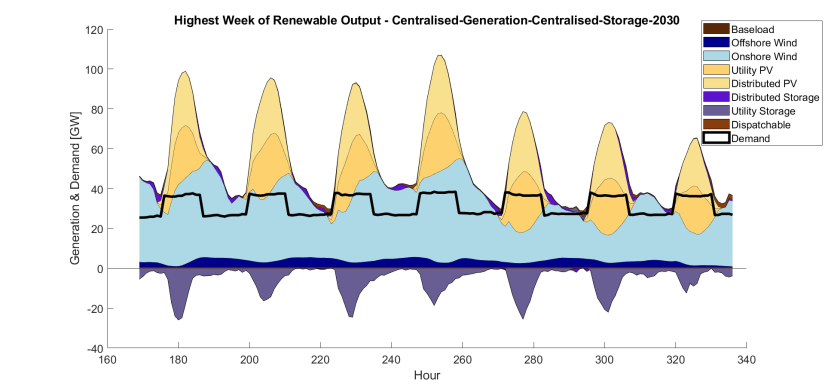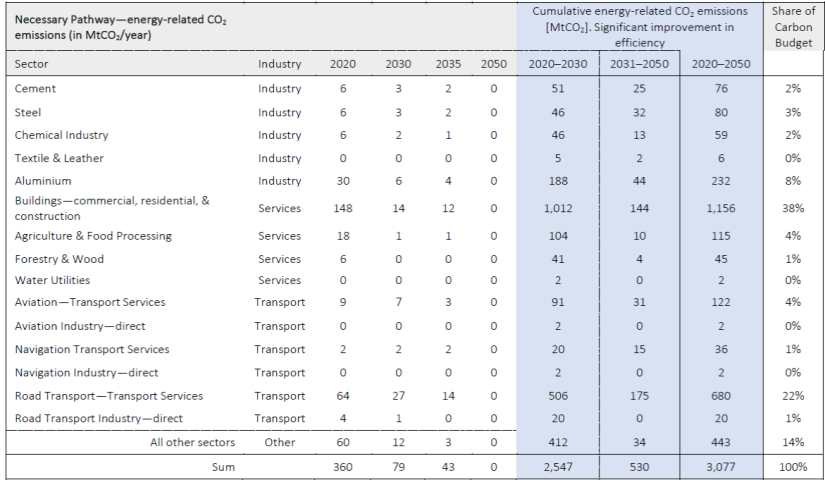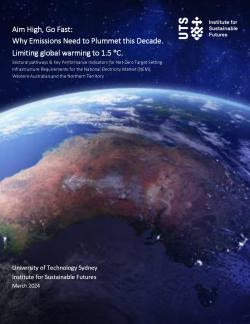ISF and the Australian Climate Council developed a climate and energy pathway for Australia as part of the One Earth Climate Model research project.
Graphic: Simulation of Australia's renewable electricity generation in an hourly resolution throughout the year and across 11 grid regions – the picture shows a week of high renewable output for the year 2030 in the NEM (National Electricity Market)
There is a substantial gap between what the science says is necessary for decarbonisation and the plans that are underway or proposed for Australia. The Climate Council’s foundational report Aim High, Go Fast: Why Emissions Need to Plummet this Decade underpin the Climate Council’s science-based vision for what Australia’s effort should look like: a 75% reduction from 2005 levels by 2030, reaching net zero by 2035.
Achieving this level of deep emissions reduction will not be straightforward. As part of building further momentum and ratcheting up strong climate action, we must identify and socialise the ‘next wave’ of effective climate action that will allow Australia to cut its emissions steeply in this decade (and beyond).
The Climate Council, Australia’s leading community-funded climate change communications organisation, has commissioned the Institute of Sustainable Futures at the University of Technology Sydney to model how far emissions reductions can be accelerated by 2030 and 2035. ISF has already modelled a pathway by which Australia can achieve real zero energy-related emissions by 2050. This project involves the further assessment of how much key technologies and solutions must be accelerated to achieve emissions reductions at a science-aligned scale.
This report aimed to provide scientific input to future energy planning for the ongoing debate about Australia’s energy transition as well as advise for the planned update of Australia’s National Determined Contributions (NDC) which is due in 2025.
The report includes simulations of the national grid capacity required now and, in the future, and the necessary linkages between different parts of the Australia’s power grid. The simulations support the assessment of the grid expansion requirements, the power-trade balance, and the investments required to strengthen the backbone of Australia’s electricity infrastructure to ensure its reliability and resilience.
Key research results
- Australia can reduce its energy-related CO2 emissions by 75% relative to 2005 levels by 2030. The Necessary Ambition scenario will lead to energy-related CO2 emissions of 82 MtCO2 in 2030 and 43 MtCO2 in 2035.
The energy sector will be entirely decarbonised just before 2050.
- The overall carbon budget for Australia until full decarbonisation is calculated to be 3 GtCO2 between 2020 and 2050. In this analysis, we developed a sector-specific carbon budgets for 15 sectors (see table 29). The research indicates that there are no technical barriers to achieving full decarbonisation in all the sectors analysed.
- To achieve these ambitious decarbonisation pathways, a wide spectrum of technologies is required and policies to implement those pathways must be comprehensive and long-term.
- For the power sector, solar photovoltaic is the key renewable energy technology for Australia, but diversity is required to keep the storage demand low and the security of supply high. All renewable power technologies—on- and offshore wind, geothermal power, and concentrated solar power plants—are important for the successful decarbonisation of Australia’s power sector.
- For the industry sector, the generation of electrical process heat and thermal process heat based on hydrogen and synthetic fuels is among the most important new technological developments.
- For the transport sector, the electrification of road and rail transport vehicles, increased active transport, such as cycling and walking, and consistent policies are the key measures and among the most challenging for Australia, given the geography of the country.
- For the building sector, significant improvements in building efficiency in terms of the building envelope and double glazing are key.
To conclude, Australia can decarbonise its economy with existing technologies, but not with existing policies.
Necessary Pathway—energy-related CO2 emissions (in MtCO2/year)
Download the report
Researchers: Sven Teske, Jonathan Rispler and Saori Miyake



